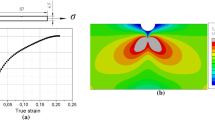Abstract
Digital Image Correlation is used for controlling load shedding fatigue crack propagation. A specific algorithm is used to perform Stress Intensity Factors (SIFs) and crack length estimation in real time. Crack length measurements are validated by comparison with potential drop technique. SIFs results are compared with more common techniques using standard analytical formula considering confined plasticity at the crack tip. The proposed non-contact method is shown to be a powerful tool to control crack propagation.













Similar content being viewed by others
References
Bui H (2006) Fracture mechanics: inverse problems and solutions. Springer Verlag
Bathias C, Pineau A (1980) La fatigue des matériaux et des structures. Maloine
Oh C, Earmme Y, Song J (1997) Automated real-time measurements of fatigue crack length and crack opening load using unloading elastic compliance method. Int J Fatigue 19(2):169–176
Johnson H (1965) Calibrating the electric potential method for studying slow crack growth (calibration of electric potential technique to study slow or steady crack growth in high strength materials). Mater Res Stand 5:442–445
Mann T, Harkegaard G, Stark K (2007) Short fatigue crack growth in aluminium alloy 6082-T6. Int J Fatigue 29(9–11):1820–1826
Dawicke D, Sutton M, Newman Jr J, Bigelow C (1999) Measurement and analysis of critical CTOA for an aluminum alloy sheet. Fract Mech 25:358–379
Sutton M, Zhao W, McNeill S, Helm, J, Piascik R, Riddell W (1999) Local crack closure measurements: development of a measurement system using computer vision and a far-field microscope. Advances in fatigue crack closure measurement and analysis, pp 145–156
Tada H, Paris P, Irwin G (2000) The stress analysis of cracks handbook, 3rd edn
Lyons J, Liu J, Sutton M (1996) High-temperature deformation measurements using digital-image correlation. Exp Mech 36(1):64–70
Kovac J, Alaux C, Marrow T, Govekar E, Legat A (2010) Correlations of electrochemical noise, acoustic emission and complementary monitoring techniques during intergranular stress-corrosion cracking of austenitic stainless steel. Corros Sci 52(6):2015–2025
James M, Pacey M, Wei L, Patterson E (2003) Characterisation of plasticity-induced closure–crack flank contact force versus plastic enclave. Eng Fract Mech 70(17):2473–2487
Diaz F, Patterson E, Tomlinson R, Yates J (2004) Measuring stress intensity factors during fatigue crack growth using thermoelasticity. Fatigue Fract Eng Mater Struct 27(7):571–583
MCneill S, Peters W, Sutton M (1987) Estimation of stress intensity factor by digital image correlation. Eng Fract Mech 28(1):101–112
Réthoré J, Gravouil A, Morestin F, Combescure A (2005) Estimation of mixed-mode stress intensity factors using digital image correlation and an interaction integral. Int J Fract 132(1):65–79
Roux S, Hild F (2006) Stress intensity factor measurements from digital image correlation: post-processing and integrated approaches. Int J Fract 140(1):141–157
Roux S, Réthoré J, Hild F (2009) Digital image correlation and fracture. J Phys D: Appl Phys 42:214004–214024
Irwin G (1960) Plastic zone near a crack and fracture toughness. In: Proceedings of 7th Sagamore conference, pp 4–63
Tay T, Yap C, Tay C (1995) Crack tip and notch tip plastic zone size measurement by the laser speckle technique. Eng Fract Mech 52(5):879–885
Henninger C, Roux S, Hild F (2010) Enriched kinematic fields of cracked structures. Int J Solids Struct 47:3305–3316
ASTM Standard (1995) E647-95. In: 1995 ASTM annual book of standards, vol 3, pp 578
Xu T, Bea R (1997) Load shedding of fatigue fracture in ship structures. Mar Struct 10(1):49–80
AFNOR (1992) Produits siderurgiques, essais mecaniques, partie 2: fatigue mecanique de la rupture
Comite Europeen de Normalisation CE (1999) Protection contre la corrosion: terminologie essais de corrosion et protection cathodique, vol 1. AFNOR CEFRACOR
Williams M (1957) On the stress distribution at the base of a stationary crack. ASME J Appl Mech 24:109–114
Hamam R, Hild F, Roux S (2007) Stress intensity factor gauging by digital image correlation: application in cyclic fatigue. Strain 43(3):181–192
Author information
Authors and Affiliations
Corresponding author
Rights and permissions
About this article
Cite this article
Durif, E., Réthoré, J., Combescure, A. et al. Controlling Stress Intensity Factors During a Fatigue Crack Propagation Using Digital Image Correlation and a Load Shedding Procedure. Exp Mech 52, 1021–1031 (2012). https://doi.org/10.1007/s11340-011-9552-6
Received:
Accepted:
Published:
Issue Date:
DOI: https://doi.org/10.1007/s11340-011-9552-6




